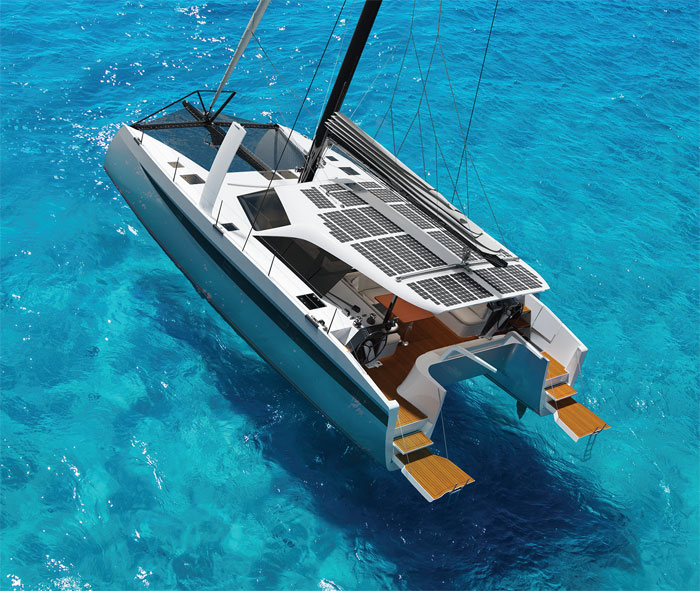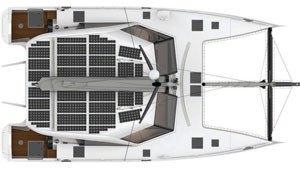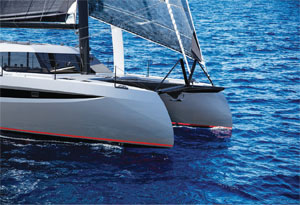

Big, fast, ocean-capable cats are where it’s at right now and the ever-expanding Hudson Yacht Group range is right at the front of the action. And now there is another one...
Going fast while being safe and comfortable is what the luxury performance catamaran genre is all about. For almost a decade the Hudson Yacht Group with its brand HH Catamarans has been a proven innovator by providing this market with several offerings between 50 to 88 feet in length to satisfy this niche, and have developed numerous refinements to the essential elements of design, style and functionality to make them the recognised leader in this field.
Now HH Catamarans has an exciting new product that brings much of the technology and innovation developed for larger platforms to a size that is accessible to a much broader range of customers: the new HH44. ‘This boat is very exciting for us,’ explained Paul Hakes, chief of operations at the Hudson Yacht Group. ‘Its size at 44 feet makes it more affordable in cost and space than our larger boats, but still large enough to sail most anywhere in the world and still deliver the comfort, speed, safety and reliability of the larger yachts.’
Hakes also explained this is the first wholly in-house design for HH Catamarans, with his son James taking the lead as principal designer. His formal naval architect and engineering qualifications as well as many years working with some of the best yacht designers from around the world has given him valuable insight to both the design process and the practical elements of highquality production boatbuilding, not to mention many years of working weekends and summer holidays as a school kid in his father’s previous boatyard.
‘James knows our processes here, so this is a big advantage in developing practical designs around new concepts,’ says Hakes. ‘This has been especially important in the development of the 44, which has several new features not found in the other larger designs in our product line. We wanted to take some bold new steps forward with the 44, and James has been right there with new ideas that are still possible within the production and budget targets.’
Hakes explains first the boat needed to have a bold new look, not just a scaled-down retread of larger designs, and that it must make an immediate impression to have the look and feel of being new and exciting. To reduce the boxy look of high freeboards that many other 40ft catamarans suffer from, for example, the topside windows with integrated portlights are continuous along the hull and the dark colored moulded swoosh-shaped impression extends to the transom.
The low angles of the deckhouse sides not only reduce aerodynamic drag, but are designed to create a sleek, functional look to the structure, while also providing adequate cover from the elements, whether it’s spray or sun.
Efficient sailing systems
Performance has always been an important factor in the development of HH Catamaran designs and the HH44 is no exception. And it’s more than just having an appropriate power to weight ratio in the sailplan to make the boat come alive when sailing, but also having the efficiency and functionality in the sail control systems to make sailing easy and fun for a limited number of owner/crew that would typically be aboard a boat of this size.
First, the sailplan supported by the Marstrom-built carbon spar and rigging is generous: 125.3m2 of upwind sail area with the main and solent jib, which expands to 223.1m2 of downwind sail area with the addition of the 148.9m2 gennaker or 109.7m2 reacher. For a 13.4m length and only 12,500kg of full-load displacement this is an impressive power to weight ratio for any boat in this class.
‘Our hulls are always designed to handle their payload well,’ says designer James Hakes, ‘so you will see the speed does not dramatically reduce at full load.
Secondly, the main traveller location on the roof is out of the way but still accessible when needed, controlled via push buttons at each helm station.
Thirdly, the headsails and gennaker are on low-friction furler systems that are accessible and able to deploy and douse with a shorthanded crew, with all furling lines led back to the aft helm stations.
Fourth, all lines, sheets, halyards led from the mast underdeck with winch and clutch placement at the helm stations make for easy shorthanded sailing. The helm pedestal’s ability to pivot inboard or outboard is also a great feature to enhance visibility or duck out of the sun or weather.

Unlike their larger brethren, HH44s will not be built with full carbon hull skins as this does not offer a weight reduction at this size, but resin-infused E-glass and M Foam composite epoxy laminates with a carbon skeleton comprising of all bulkhead, stringers, beams and reinforcing for loaded areas – Hakes says there is little to gain to justify the material cost of using 100 per cent carbon in a boat this size. A mix of quality composite materials is most appropriate with this platform to keep the costs realistic. Nonetheless, carbon is used throughout the boat where its strength and light weight is ideally suited to the engineering integrity of the structures… such as the monocoque longeron, martingale and truss structures that tie together the loads from the hull bows to the spar through the headstay. This critical part also features an anchor and tackle deployment system in a clever design of combined functions into one integrated part.
There are numerous other clever design features on the HH44 that make for functional versatility without compromise on performance. Such as:
- Large, flat windows that open for flow-through ventilation under the canopy
- Standard fold-down steps and swim platform on the sterns for easy access when deployed and safe enclosure of the cockpit and saloon area while sailing
- An optional side boarding gate for direct side access from dock to aft deck
- Fold-down helm station seat, available if needed and out of the way when not
- Curved carbon daggerboards that increase upwind and reaching performance, retract for slippery downwind performance and are positioned to have minimal impact on interior hull volume
Eco-friendly parallel hybrid power
Another important innovation in the HH44 is that the entire cabin top is covered in solar panels. This is not an add-on afterthought, but designed and built to be integral to the concept of achieving environmental sustainability while retaining functionality of the boat’s propulsion and power management systems.
These solar panels are highly efficient, delivering 3.2kW of electrical energy with the option of adding more to provide another ½kW of energy. These power delivery figures are impressive and represent averages centered around midlatitude weather conditions and not just in the tropical sun. Considering luxury yachts of this size are typically equipped with diesel generators that produce 5kW of energy, the weight savings in not needing that engine, all its fuel supply and exhaust systems are considerable and contribute directly to performance – remember, in multihulls stability is achieved by hull and appendage geometries, not by keel weight, so every kilogram saved counts.

This solar power plant on the HH44 delivers as much power in a day as five to six hours of running a genset, and is thus integral to the design concept of being sustainably independent while cruising (or racing). It fits what Hakes calls a “parallel hybrid” solution to managing power on board for both propulsion and energy management.
‘It’s a clear trend that our customers are interested in having the independence that comes from sailing a catamaran to their destinations of choice,’ says Hakes, ‘and they want to do this in an efficient yet environmentally sustainable way. The development of new technologies to meet this demand has been outstanding in recent years, so we’re pleased to integrate the use of these systems into the HH44.’
The Parallel Hybrid can function in several different modes to service the needs of the modern sailor.
- Electric propulsion – 10kW per shaft (20kW total) allowing silent fume free motoring at seven knots for two hours, powered from the batteries and the sun. This would be valuable in scenarios where the noise, exhaust and vibration of running the engines conventionally may not be ideal – like an early departure from a quiet anchorage where the neighbours should not be disturbed.
- Hydrogeneration - Similarly, this system is a hydro genset so that when sailing the HH44 can generate electrical energy to replenish the batteries. This approach is impressive because it can deliver free power to operate the amenities on board (climate control system, galley appliances, lights, entertainment system, etc) while still at a low carbon footprint.
- Generator mode – If you are at anchor and there is no wind to sail, nor sun for solar power. You can turn on the diesel engines and send 12kW of electrical power directly into the batteries, fully charging them from empty in three hours.
- Engine mode – You still have two trusty 30hp diesel engines for when you need them, and while you are using them you are again sending upto 6kW per engine back into the batteries.
‘It turns out that parallel hybrid systems have been in use on canal boats in inland waterways for many years, where you have the known reliability and safety of a diesel engine turning the propeller, or the gearbox can switch to electric power’ says Hakes. ‘And we learned about them while building eleven hybrid CNG/electric-parallel hybrid powered boats for the Shanghai Disney Park a few years ago, and this opened our eyes to future applications.’
There is also a safety and security benefit to having redundant systems while long-distance cruising because the HH44 in effect has four power plants: two diesel and two electric. If one fails there are back-ups, which can be vitally important in some circumstances where reliable power or propulsion is needed immediately.
VPP analysis by KND in Valencia indicates that in a racing displacement mode of 10,900kg, the HH44 should achieve the following figures:
| TWS | 46-50 | 80 | 100 | 120 | TWA |
| 6 | 5.35 | 8.41 | 8.47 | 7.69 | kts boatspeed |
| 10 | 7.71 | 12.25 | 12.28 | 9.81 | |
| 20 | 12.43 | 19.90 | 21.5 | 21.17 |
| TWS | 46-50 | 80 | 100 | 120 | TWA |
| 6 | 5.03 | 7.44 | 8.24 | 6.74 | kts boatspeed |
| 10 | 7.57 | 9.98 | 11.18 | 9.19 | |
| 20 | 12.09 | 19.95 | 21.92 | 19.92 |
HH Catamarans offers an extensive list of options for the 44 letting owners appoint their yacht to suit their individual needs, including a huge sail wardrobe to choose from. As for all-out customisations, the HH44 has very few, unlike its larger cousins. This is not only because Hudson Yacht Group wishes to keep the production costs and timing as streamlined as possible to deliver this boat to market… it’s also because this design represents decades of accumulated boatbuilding expertise and 10 years of careful thought and evolution towards what should be the ideal performance luxury catamaran of this size.
As Hakes says, ‘this is the boat I have always wanted to build’.
Click here for more information on HH Catamarans »
We invite you to read on and find out for yourself why Seahorse is the most highly-rated source in the world for anyone who is serious about their racing.
To read on simply SIGN up NOW
Take advantage of our very best subscription offer or order a single copy of this issue of Seahorse.
Online at:
www.seahorse.co.uk/shop and use the code TECH20
Or for iPad simply download the Seahorse App at the iTunes store


